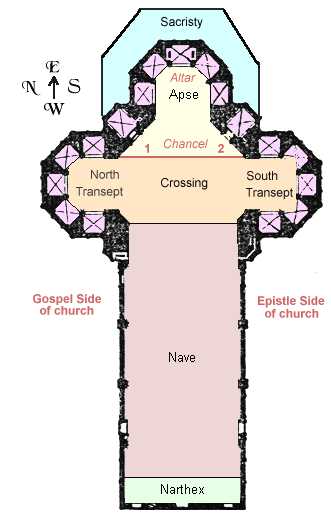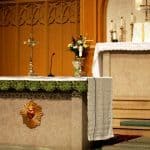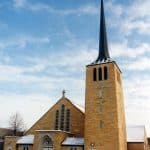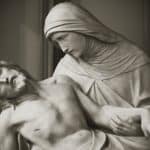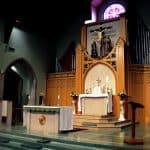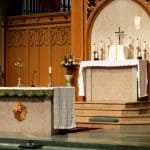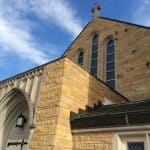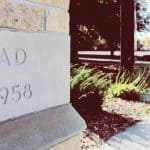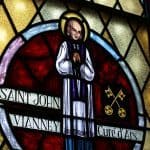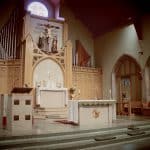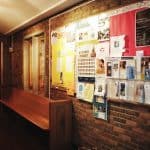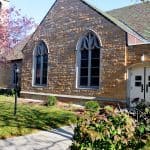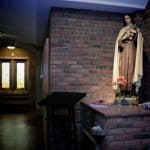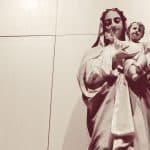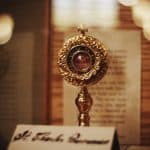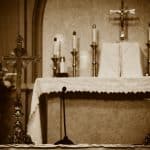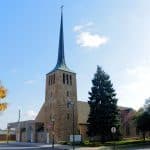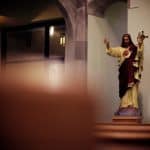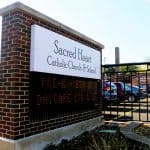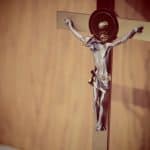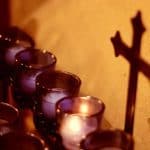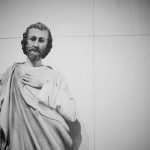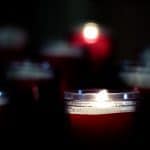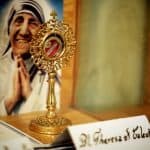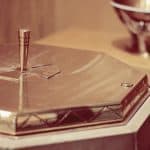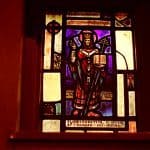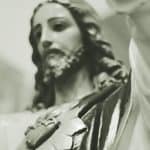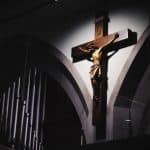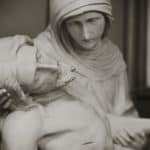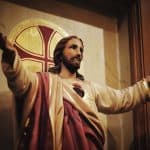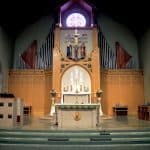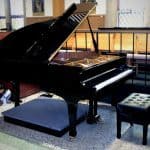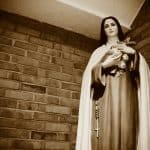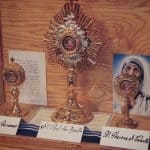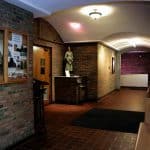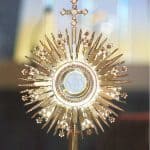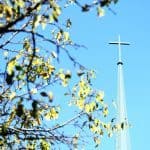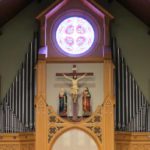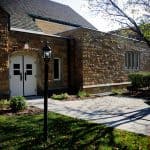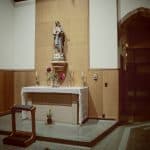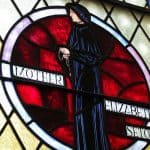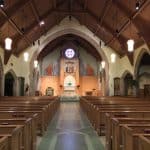Catholic vision assigns symbolic meaning to the various parts of the church building, as it does to pretty much everything else in the world. The roof symbolizes charity, which covers a multitude of sins; the floor symbolizes the foundation of faith and the humility of the poor; the columns represent the Apostles, Bishops, and Doctors; the vaulting represents the preachers who bear up the dead weight of man's infirmity heavenwards; and the beams represent the champions of ecclesiastical right who defend it with the sword. The nave symbolizes Noah's Ark and the Barque of St. Peter, outside of which no one is saved. The direction of the East represents the Heavenly Jerusalem, and the direction whence the Messiah will return in glory; West represents death and evil.
– Catholic Encyclopedia
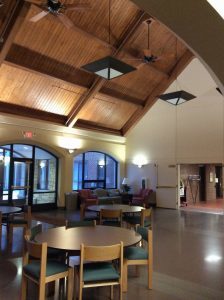 A true narthex is either an outside, covered porch-like structure or an inside area separated from the nave (the "body" of the church) by a screen, but this word has come to mean "entry" or "foyer." Originally, penitents and Catechumens were confined to this area until their reconciliation with or initiation into the Church. A westwork (or "westwerk") is the front of a large cathedral that has a tall facade and, usually, towers and an upper chamber (imagine the front entry of Notre Dame Cathedral in Paris with its towers and sculpture).
A true narthex is either an outside, covered porch-like structure or an inside area separated from the nave (the "body" of the church) by a screen, but this word has come to mean "entry" or "foyer." Originally, penitents and Catechumens were confined to this area until their reconciliation with or initiation into the Church. A westwork (or "westwerk") is the front of a large cathedral that has a tall facade and, usually, towers and an upper chamber (imagine the front entry of Notre Dame Cathedral in Paris with its towers and sculpture).
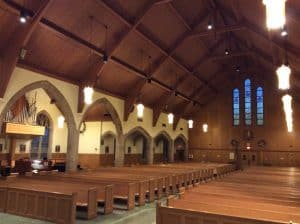 Referring to the "barque of Peter" and "Noah's Ark," the word "nave" is derived from the Latin word for ship, navis, and has come to mean the area where the parishioners sit or stand (pews are a very late addition to the nave area, and, even today, parishioners stand during the liturgy in many Eastern Catholic and Orthodox Churches). In Gothic architecture, the nave had an aisle (or two) on both sides.
Referring to the "barque of Peter" and "Noah's Ark," the word "nave" is derived from the Latin word for ship, navis, and has come to mean the area where the parishioners sit or stand (pews are a very late addition to the nave area, and, even today, parishioners stand during the liturgy in many Eastern Catholic and Orthodox Churches). In Gothic architecture, the nave had an aisle (or two) on both sides.
The place where the nave, chancel and transept intersect. This area is often domed.
The transverse arm of a cruciform church is called the transept. Because the liturgy is supposed to be celebrated ad orientem (facing East), the left side of the transept is called the North transept and the right side of the transept is called the South transept. This is so even if the actual orientation of the Church is other than with the Altar at the East side. Some churches have transepts at the West end of the church, too — especially English Gothic churches.
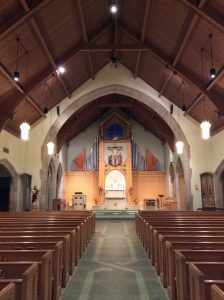 The word "chancel" comes from the word cancelli, meaning "lattice work," once used to rail off the choir, where the religious would sit on long benches to sing the responses at Mass and chant the Divine Office, from the nave, where the people sit.
The word "chancel" comes from the word cancelli, meaning "lattice work," once used to rail off the choir, where the religious would sit on long benches to sing the responses at Mass and chant the Divine Office, from the nave, where the people sit.
Medieval churches often had "rood screens" ("rood" means "cross") separating the Sanctuary and choir from the body of the nave. The rood screen had the rood -- the Crucifix -- often flanked by images of the Virgin and St. John and by oil lamps. This screen totally separated the sanctuary from the place the people sat so that the sanctuary was truly treated as the Holy of Holies. (In Eastern Catholic churches and in Orthodox churches, the sanctuary is separated from the congregation by a lovely iconostasis -- a screen or wall with at least two icons (some are covered with them). The iconostasis has three doors: the Door of the Proskomide (preparation for Liturgy) on the left; the Royal Door in the middle which leads directly to the altar; and the Deacon's Door at the right (from the parishioner's point of view).The rise of Renaissance architecture saw the disappearance of the choir area, the bringing forward of the sanctuary, and the general disappearance of the rood screens. The sanctuary was, instead, separated from the nave (as they should be today if there is no rood screen or iconostasis) by altar rails at which communicants must kneel to receive the Eucharist.
Aside from being the place of the Altar, the sanctuary is the place where the Tabernacle, which holds the Blessed Sacrament, is kept and over which there should always be burning a tabernacle light. The other place where the Tabernacle might be kept is a separate, conspicuous, well-adorned side chapel in churches in which the Altar area is used for the solemn conduct of the Divine Office or for Pontifical ceremonies. When we see the Tabernacle, we genuflect. If the Blessed Sacrament is exposed, we kneel on both knees.
As the term is commonly used in church architecture, "apse" denotes the often domed, semicircular or polygonal termination where the altar is located.
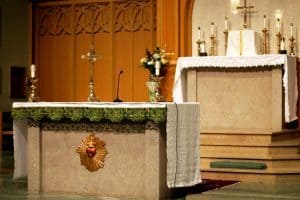 The High Altar (the main altar) is the place where the Eucharistic Sacrifice is offered (in a single church, there should be more than one Altar). While ancient synagogue liturgy was oriented toward Jerusalem, Christian liturgy is supposed to be celebrated with the priest and the congregation facing East ("ad orientem"), the direction whence Jesus, as symbolized by the rising Sun, will come again; the High Altar , therefore, has traditionally been at the East side of the church. In older churches, you might still see gorgeous altar screens or "Altar pieces" behind the Altar. The more fanciful, ornate ones are called "reredos" and can be quite exquisite, full of sculpture and with different panels.
The High Altar (the main altar) is the place where the Eucharistic Sacrifice is offered (in a single church, there should be more than one Altar). While ancient synagogue liturgy was oriented toward Jerusalem, Christian liturgy is supposed to be celebrated with the priest and the congregation facing East ("ad orientem"), the direction whence Jesus, as symbolized by the rising Sun, will come again; the High Altar , therefore, has traditionally been at the East side of the church. In older churches, you might still see gorgeous altar screens or "Altar pieces" behind the Altar. The more fanciful, ornate ones are called "reredos" and can be quite exquisite, full of sculpture and with different panels.
The High Altar should: be fixed, of natural stone (bishops conferences have some leeway here), and contain a relic of a Saint (martyrs are favored). The Altar is venerated because it is the place of sacrifice, and because it is the place of Sacrifice, the Tabernacle is usually kept on it.
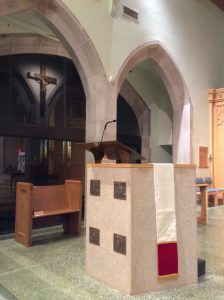 The podium on the left side of the church as you face the Altar (the "Gospel side"), from where the Gospel is read (and which is reserved for clergy). Not all churches have both a lectern (see below) and a pulpit; some just have one single speaker's podium called an ambo. Note that the Gospel side of the church is also informally referred to as the "Mary side" of the church because it is there a statue of her is often placed.
The podium on the left side of the church as you face the Altar (the "Gospel side"), from where the Gospel is read (and which is reserved for clergy). Not all churches have both a lectern (see below) and a pulpit; some just have one single speaker's podium called an ambo. Note that the Gospel side of the church is also informally referred to as the "Mary side" of the church because it is there a statue of her is often placed.
The stand on the right side of the church as you face the Altar (the "Epistle side") from where the Epistles are read (and which can be used by lay-people). Not all churches have both a lectern and a pulpit (see above); some just have one single speaker's podium called an ambo. Note that the Epistle side of the church is also informally referred to as the "St. Joseph side" of the church because it is there a statue of him is often placed.
You can remember which side of the Church is which by taking the vantage point of Christ on the Crucifix: His right is the Gospel/Mary side of the Church; His left is the Epistle/Joseph side of the Church. Mary and the Gospel are greater than Joseph and the Epistle so are at Jesus' right. This will be so unless there is a statue of, say, our Lord, in which case it will be placed to the right of Jesus' vantage point from the Crucifix while Mary is to the left.
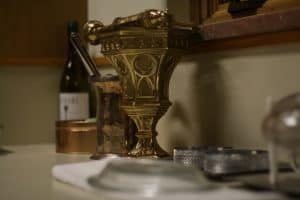 The Sacristy is where sacred vestments, liturgical vessels, etc., are stored. When the sacristy is behind the chancel and has two entrances, the priests enter on the Gospel side and exit through the Epistle side door.
The Sacristy is where sacred vestments, liturgical vessels, etc., are stored. When the sacristy is behind the chancel and has two entrances, the priests enter on the Gospel side and exit through the Epistle side door.
In the sacristy you will find the sacrarium -- a special sink with a pipe that bypasses the sewer, unlike an ordinary sink, but instead goes straight into the earth. This sink is made thus to preserve the dignity of sacred things which can no longer be used. For ex., the sacred vessels are rinsed there so that no particle of the consecrated Host or no drop of the Precious Blood will end up in the sewer. The first rinse used to clean Altar linens, old baptismal water, sacred oils, blessed ashes, etc., all these are disposed of in the sacrarium, returning those substances to the earth.
Descriptions provided by FishEaters.com.

